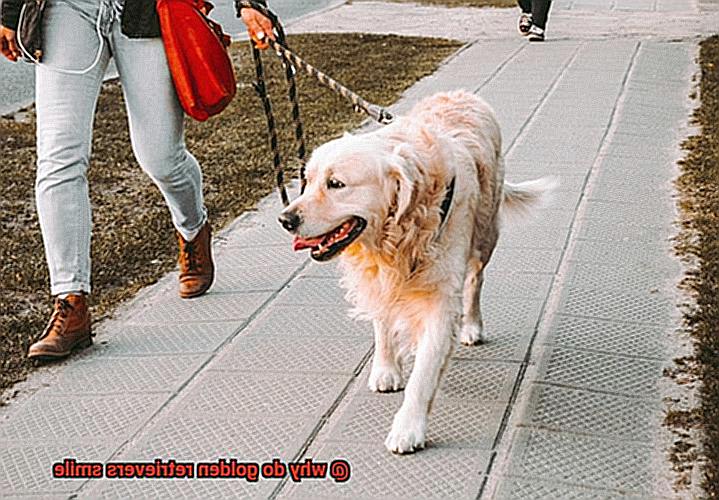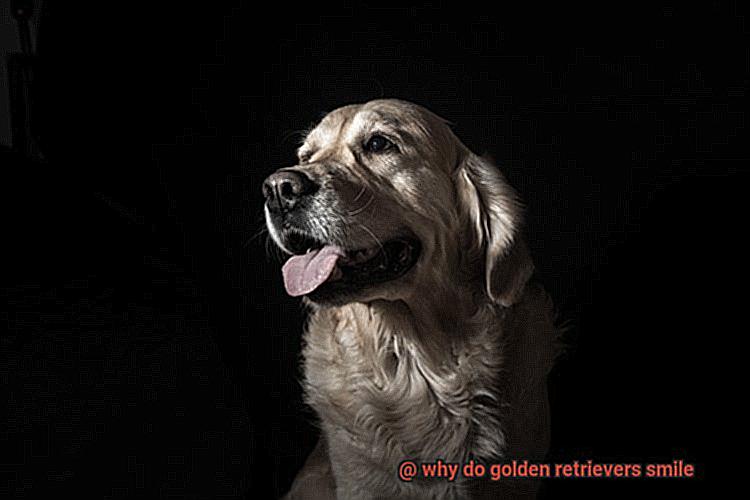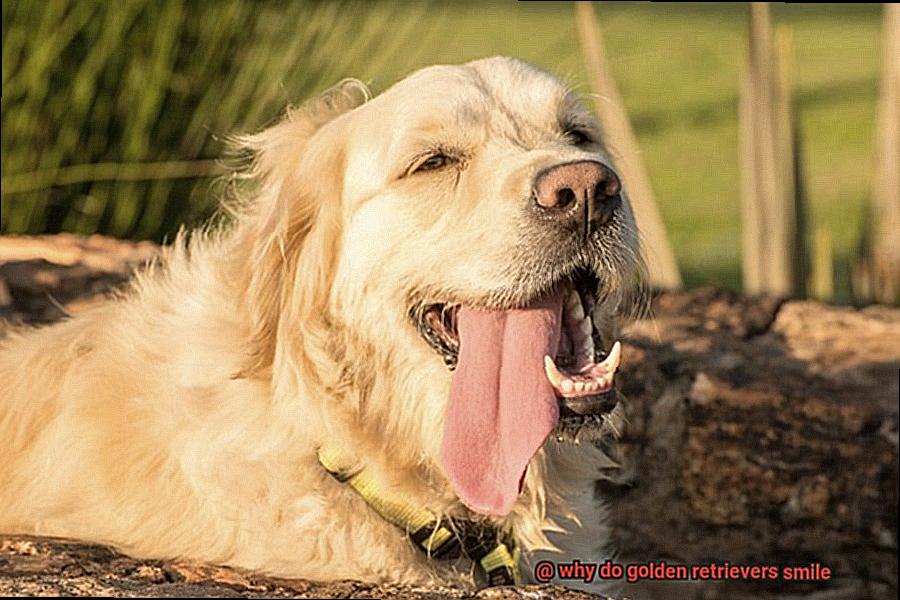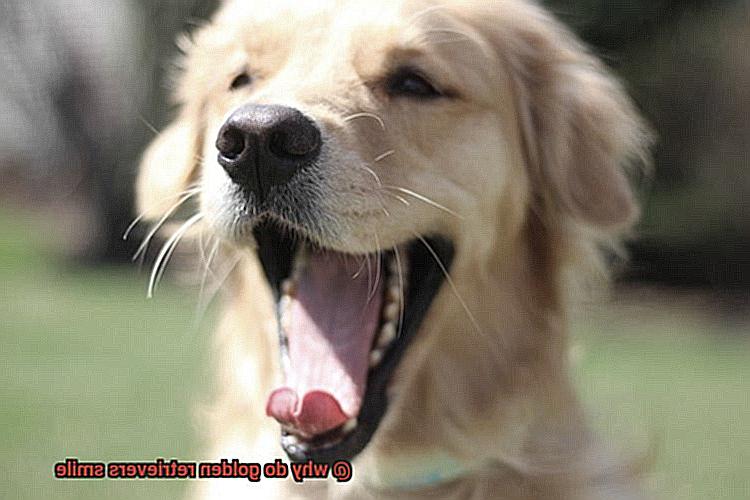Are you a golden retriever enthusiast? If you are, then you must have noticed that this breed has a unique way of expressing their joy and affection – through their irresistible “smile.” This fascinating trait has been the subject of many discussions among dog lovers, but finally, we have an answer to the question: why do golden retrievers smile?
Firstly, let’s clarify that it isn’t an actual smile as dogs can’t smile like humans. However, it is an expression of happiness and contentment that’s exclusive to this breed. Golden retrievers are known for being friendly and outgoing, and their “smile” is just another way they show love and excitement towards their human companions.
The primary reason behind golden retrievers’ constant grin is due to their distinct facial structure. Their broad and muscular jaw naturally turns up at the corners, giving them a perpetual happy face. Moreover, they have large, expressive eyes that contribute to their friendly appearance.
Golden retrievers are also highly intuitive animals who can sense their owner’s emotions and respond accordingly. When their owner is happy and relaxed, they reflect that energy by smiling right back at them.
In conclusion, golden retrievers smile because of their unique facial structure, friendly personalities, and ability to sense human emotions. If you’re fortunate enough to have one of these lovable pups in your life, you already know how infectious their “smile” can be and how much joy they bring into your daily routine.

– Definition of Golden Retriever Smile
Contents
- 1 – Definition of Golden Retriever Smile
- 2 What is the Purpose of a Golden Retriever Smile?
- 3 How Do Golden Retrievers Express Happiness?
- 4 What Are the Different Types of Golden Retriever Smiles?
- 5 How Can I Encourage My Dog to Smile?
- 6 Training Tips for Teaching Your Dog the “Smile” Command
- 7 The Importance of Positive Reinforcement
- 8 Conclusion
It’s called the “Golden Retriever Smile” and it’s a sight to behold. This unique expression is characterized by the dog opening its mouth wide, exposing its teeth, and letting its tongue hang out.
But what causes this adorable expression? While there isn’t a definitive answer, experts have a few theories. One idea is that it’s an instinctive behavior inherited from their wolf ancestors. Wolves use this type of expression as a non-threatening gesture to communicate with other pack members. Golden Retrievers may have inherited this behavior from them, adapting it as a way to communicate with their human families.
Another theory suggests that Golden Retrievers smile as a way to connect with their owners. As social animals, dogs have learned to read human emotions and respond accordingly. By smiling, they may be trying to convey happiness or excitement to their owners, who they see as part of their pack.
Regardless of the reason behind it, the Golden Retriever Smile is one of the many reasons why this breed is so beloved by dog lovers around the world. It’s a natural behavior that reflects their friendly and affectionate nature. If you have a Golden Retriever, you can encourage this behavior by providing plenty of positive interactions, exercise, and playtime.
What is the Purpose of a Golden Retriever Smile?
Golden Retrievers are some of the most loving and friendly dogs on the planet, and their signature smile is one of the reasons why. This big, toothy grin can make anyone’s heart melt, but have you ever wondered what the purpose of this adorable behavior is? As an expert in this field, I am here to give you the lowdown on the purpose of a Golden Retriever Smile.
One theory suggests that this smile is a social cue used by these dogs to communicate with humans and other animals. As social creatures, dogs use body language to convey a range of emotions and intentions. By smiling, a Golden Retriever may be signaling that it is friendly, approachable, and non-threatening. So, if you see a Golden Retriever with a big smile on its face, it means that they are happy to see you.
Another possible explanation for this behavior is that it is an instinctual behavior inherited from their wolf ancestors. Wolves often bare their teeth as a sign of submission or appeasement when interacting with other wolves or higher-ranking members of their pack. In domesticated dogs like Golden Retrievers, this behavior may have evolved into a more positive expression of friendliness and submission.
Regardless of the underlying reason for the smile, it’s clear that these dogs use this behavior to build positive relationships with humans and other animals. Their smiling faces are a reflection of their outgoing personalities and their desire to make others happy. A Golden Retriever’s smile is not just an adorable facial expression – it’s a powerful tool for building connections with those around them.
Social Interaction
These lovable creatures are known as the “perfect family dogs” due to their sociable nature.

One of the most endearing traits of golden retrievers is their unique way of expressing happiness – through their smiles. Yes, you heard that right. When these dogs are content and joyful, they show it off with an adorable grin that can warm anyone’s heart. The smile is often accompanied by a wagging tail and playful behavior, which signifies their approachable and sociable personality.
However, some people misinterpret the golden retriever’s smile as a sign of aggression or baring teeth. It is important to understand that this behavior is a sign of affection and happiness. Owners must comprehend this behavior to avoid reacting inappropriately.
Golden retrievers are social animals that thrive on human interaction. They enjoy being part of the family and spending quality time with their owners. Additionally, they love socializing with other dogs and meeting new people. Their friendly nature and willingness to interact make them great companions for both adults and children alike.
Temperature Regulation
Golden retrievers, known for their friendly nature, are also famous for their adorable smiles. But did you know that when they grin, they’re actually showing they’re happy and relaxed in their environment?
Dogs regulate their body temperature through panting, a form of relaxed breathing. When a golden retriever smiles, they’re essentially panting through their mouth – helping them to cool down. This is especially important during hot weather or when they’re playing outdoors.
Apart from temperature regulation, dogs use facial expressions to communicate with humans and other animals. A smile can indicate that a dog is happy or content, but it can also be a sign of submission or appeasement. Golden retrievers, being social dogs, often use their smiles to convey friendly intentions to other dogs and humans.
However, it’s crucial to understand that while a smile may indicate happiness or relaxation, it’s not always a reliable indicator of a dog’s mood or temperament. Each golden retriever has a unique personality and may exhibit different behaviors in various situations. As owners, we must be aware of our dog’s body language and behavior to ensure they’re happy and healthy.
How Do Golden Retrievers Express Happiness?
One of the most endearing ways they show their happiness is through frenzied tail-wagging. When excited or content, Golden Retrievers wag their tails in a circular motion that shows just how ecstatic they are. It’s like they can’t contain their joy and need to share it with the world.
However, tail-wagging is not the only way Golden Retrievers express their happiness. They also use their body language to convey their emotions. They tend to stretch out and lie down on their backs, exposing their belly. This posture is a sign of trust and vulnerability, indicating that they feel comfortable and safe in their environment.
Vocalization is another way that Golden Retrievers communicate their emotions. When happy, these dogs often bark or make playful noises, indicating just how joyful they are feeling. It’s like they want to spread happiness with every sound they make.

And finally, perhaps the most heart-melting way that Golden Retrievers express happiness is through their facial expressions. These dogs have an adorable smile that can brighten up anyone’s day. When happy, Golden Retrievers tend to lift the corners of their mouths, forming a smile-like expression. It’s like they know how much happiness they bring to our lives and want to reciprocate it back to us.
What Are the Different Types of Golden Retriever Smiles?
Golden Retrievers have a special way of spreading joy wherever they go, and one of the ways they do this is through their smiles. But did you know that there are different types of Golden Retriever smiles? Let’s take a closer look.
First up is the panting smile. This is the most common type of Golden Retriever smile, and it’s when they open their mouths wide and pant while wagging their tails. This smile usually means that they’re happy and excited, whether it’s because they’re about to go for a walk or getting ready to play with their owners.
Another type of smile is the closed mouth smile. It’s a more subtle smile, and Golden Retrievers will keep their mouths closed but still show their teeth slightly. This type of smile usually means that they’re content and relaxed. You might see this when they’re lounging around or getting some much-needed belly rubs.
The grinning smile is an impressive display, as these dogs will pull their lips back to show all their teeth. This type of smile can be mistaken for aggression, but it’s actually a sign of happiness and excitement. You’ll often see this type of smile when they’re playing with their favorite toys or spending time with their owners.
The sneaky smile is a unique type of Golden Retriever smile. It’s when they lift one side of their lips while keeping the other side closed. This type of smile can look mischievous, but it usually means they’re happy and playful. You might catch this type of smile when they’re up to no good, like stealing a treat from the kitchen counter.
Finally, there’s the tongue-out smile. This is when Golden Retrievers stick out their tongues while panting or grinning. It’s a sign of excitement and happiness, and it’s often seen when they’re playing or getting attention from their owners. This type of smile is hard to resist, as it shows just how much joy these dogs can bring to our lives.
How Can I Encourage My Dog to Smile?
Although dogs do not smile in the same way humans do, there are ways to encourage your furry friend to exhibit behaviors that resemble a smile. Here are some tips to help you get started:
Positive Reinforcement: One of the best ways to encourage your golden retriever to “smile” is through positive reinforcement techniques. Start by rewarding your dog with treats or praise when they exhibit any behavior that resembles a smile, such as lifting their lips or showing their teeth. By consistently rewarding these behaviors, you can encourage your dog to associate smiling with positive reinforcement.
Playtime and Exercise: Just like humans, dogs crave physical activity and playtime. Regular exercise and playtime can improve your dog’s overall mood and well-being, which can lead to a happier and more content companion. Try taking them for a walk, playing fetch, or engaging in any other activity that they enjoy.
Respect Your Dog’s Individuality: Every dog is unique and may have different behaviors and preferences. Some dogs may be more expressive and prone to smiling, while others may not be as inclined. It’s important to respect your dog’s individual personality and not force them into behaviors that may make them uncomfortable.
Training Tips for Teaching Your Dog the “Smile” Command
Training your golden retriever to smile on command is a fun and rewarding experience that can showcase your furry friend’s personality and boost their confidence around people. With the right supplies, patience, and positive reinforcement training, your golden retriever will be flashing their pearly whites in no time.

Building a Strong Bond with Your Golden Retriever
Your relationship with your dog is crucial in teaching them new tricks. By using positive reinforcement training methods and providing plenty of love and attention, you can create a strong bond that fosters trust and obedience. Spend quality time with your dog by taking walks, playing games, and cuddling on the couch.
Starting Small with Tasty Treats
Treats are an essential tool in teaching your golden retriever to smile. Start by holding a treat close to your dog’s nose and slowly moving it towards their ears. As they follow the treat with their nose, their lips will naturally curl upwards into a smile-like expression. Reward them immediately with the treat and praise.

Adding Verbal Cues for Better Communication

Introduce simple verbal cues like “smile” or “show me your teeth” during training sessions to help your dog associate the command word with the action of smiling. Be consistent with the cue and always reward them when they perform the trick correctly.
Phasing Out Treats and Reinforcing Positive Behaviors
Gradually reduce the number of treats you give your dog as they become more skilled at smiling on command. Use verbal praise, affection, and playtime as rewards instead. This reinforces positive behavior and makes training sessions more enjoyable for both you and your furry friend.
The Importance of Positive Reinforcement
Instead of punishing bad behavior, this method focuses on rewarding good behavior, and it has been proven to be more effective in training animals.
Positive reinforcement can be used in various ways to teach your golden retriever to smile. For instance, you can reward them with treats and praise when they perform the desired behavior. By doing so, you are encouraging them to repeat the behavior in the future.
However, consistency is key when using positive reinforcement. It is crucial to reward your furry pal immediately after they perform the desired behavior. Delaying the reward may confuse them and make it difficult for them to associate the behavior with the reward.
The beauty of positive reinforcement is that it not only helps in training but also strengthens the bond between you and your furry friend. By rewarding good behavior, you are showing your golden retriever that you value and appreciate them. This helps to foster a loving and positive relationship between you two, making it easier for them to learn new behaviors.
In addition to teaching your golden retriever to smile, positive reinforcement can also be used for other types of training, such as obedience and potty training. It is a humane and effective method that can help you achieve your training goals while also promoting a positive and loving relationship with your furry friend.
Conclusion
In conclusion, the Golden Retriever Smile is a heartwarming and irresistible expression that showcases their friendly and sociable nature.
Although it may not be an actual grin, this unique feature is exclusive to this breed due to their distinct facial structure, expressive eyes, and ability to sense human emotions. Golden Retrievers are social creatures who crave human interaction, making them perfect companions for both adults and children alike.
They use their smiles as a way of communicating with humans and other animals, making them exceptional at building strong relationships. To encourage your furry friend to smile, you can use positive reinforcement methods such as treats, verbal cues, and affection.
These techniques not only help teach new behaviors but also strengthen the bond between you and your furry friend.









